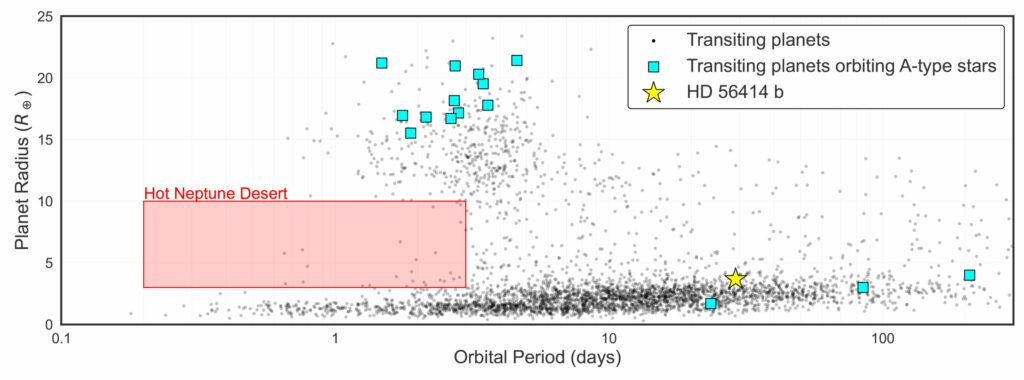American astronomers have reported the discovery of an exoplanet orbiting a hot star of spectral class A. Its study may shed light on the solution of the mystery of the “hot Neptune desert”.

The discovery was made during the analysis of data collected by the TESS space telescope. The exoplanet orbits the star HD 56414, located at a distance of 870 light-years from the Sun. It belongs to the spectral class A. Its mass is 1.9 times the mass of the Sun, and the surface temperature is 8200 °C. It is also worth noting that this system is relatively young, its age is estimated at 420 million years.
The newly found exoplanet, designated HD 56414 b, belongs to the category of hot neptunes. Its radius is 3.7 times the radius of the Earth, and its orbit passes at a distance of 0.22 au from the parent star (this is half the distance between the Sun and Mercury). It takes 29 days for one rotation.
Mystery of the “hot Neptune desert”
To date, HD 56414 b is one of the smallest exoplanets found near stars that are noticeably more massive and hotter than our Sun. The find is also interesting because it is able to shed light on the solution of the mystery of the so-called “hot Neptune desert”. We are talking about the almost complete absence of such bodies in short orbits around stars. As a rule, astronomers find either massive gas giants resembling Jupiter or Earth-like exoplanets on them.

According to one of the most popular explanations, the shortage of hot neptunes can be explained by the rapid loss of their atmosphere under the influence of radiation from the parent star (as for the larger gas giants, it is believed that they hold the gas envelope better due to their more powerful gravity).
As for HD 56414 b, although its atmosphere is heated to high temperatures, the orbit of the exoplanet still passes at a greater distance from the star than in a significant part of such cases. To test its stability, astronomers simulated the effect of star radiation on it. The study showed that even though the exoplanet is losing some part of the atmosphere, it has a fairly solid reserve that will allow it to survive for about another billion years.
According to https://phys.org
Follow us on Twitter to get the most interesting space news in time
https://twitter.com/ust_magazine

